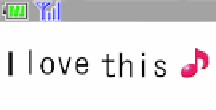Information Technology Reference
In-Depth Information
emotions and subtle nuances difficult to convey with just text. Pictograms are used to
convey emotions, and are also sometimes used in place of words. Figure 1 shows the
use of a pictogram on a mobile phone to express an emotion, while Figure 2 shows
the same pictogram used in place of a word. The musical note pictogram in Figure 1
is being used to mean'fun', while the same pictogram in Figure 2 is being used to
mean 'music'.
Fig. 1.
Example of pictogram used to express emotion
Fig. 2.
Example of pictogram used in place of word
But interpretations of pictograms vary from individual to individual—not everyone
interprets them the same way. A study of cultural differences designed to investigate
whether children in Japan and the US interpret pictograms in the same way was
carried out by giving the children a questionnaire survey asking for their
interpretations of various pictograms. It found that the children in each country had
different interpretations of pictograms related to six areas—gestures, color and
gender, time, space, familiar objects and faces/facial expressions [4]. And as shown in
Figure 3, the authors of this paper have found that during routine exchanges of mobile
phone emails with their mothers, their mothers' interpretations of the pictograms used
can sometimes differ from their own interpretations. These findings suggest that the
interpretation of some pictograms may be not only culture-specific but also age-
specific.
So a way to minimize miscommunication caused by age-specific and culture-
specific differences of interpretation of pictogram meaning would help mobile phone
pictograms carry out their intended function of conveying emotions and subtle
nuances. The aims of this research were (1) to investigate age-specific pictogram
interpretations by collecting pictogram interpretations from various age-groups (2) to
develop a prototype of an age-specific pictogram dictionary application that lets users
search and view pictogram interpretations and usage examples, and (3) to develop a
prototype of a web-based service providing multilingual translations of the
interpretations and usage examples in the search results returned by the dictionary
application.








